Luping Shi
General Automatic Solution Generation of Social Problems
Jan 25, 2024Abstract:Given the escalating intricacy and multifaceted nature of contemporary social systems, manually generating solutions to address pertinent social issues has become a formidable task. In response to this challenge, the rapid development of artificial intelligence has spurred the exploration of computational methodologies aimed at automatically generating solutions. However, current methods for auto-generation of solutions mainly concentrate on local social regulations that pertain to specific scenarios. Here, we report an automatic social operating system (ASOS) designed for general social solution generation, which is built upon agent-based models, enabling both global and local analyses and regulations of social problems across spatial and temporal dimensions. ASOS adopts a hypergraph with extensible social semantics for a comprehensive and structured representation of social dynamics. It also incorporates a generalized protocol for standardized hypergraph operations and a symbolic hybrid framework that delivers interpretable solutions, yielding a balance between regulatory efficacy and function viability. To demonstrate the effectiveness of ASOS, we apply it to the domain of averting extreme events within international oil futures markets. By generating a new trading role supplemented by new mechanisms, ASOS can adeptly discern precarious market conditions and make front-running interventions for non-profit purposes. This study demonstrates that ASOS provides an efficient and systematic approach for generating solutions for enhancing our society.
Dance of SNN and ANN: Solving binding problem by combining spike timing and reconstructive attention
Nov 11, 2022



Abstract:The binding problem is one of the fundamental challenges that prevent the artificial neural network (ANNs) from a compositional understanding of the world like human perception, because disentangled and distributed representations of generative factors can interfere and lead to ambiguity when complex data with multiple objects are presented. In this paper, we propose a brain-inspired hybrid neural network (HNN) that introduces temporal binding theory originated from neuroscience into ANNs by integrating spike timing dynamics (via spiking neural networks, SNNs) with reconstructive attention (by ANNs). Spike timing provides an additional dimension for grouping, while reconstructive feedback coordinates the spikes into temporal coherent states. Through iterative interaction of ANN and SNN, the model continuously binds multiple objects at alternative synchronous firing times in the SNN coding space. The effectiveness of the model is evaluated on synthetic datasets of binary images. By visualization and analysis, we demonstrate that the binding is explainable, soft, flexible, and hierarchical. Notably, the model is trained on single object datasets without explicit supervision on grouping, but successfully binds multiple objects on test datasets, showing its compositional generalization capability. Further results show its binding ability in dynamic situations.
Adversarial Feature Stacking for Accurate and Robust Predictions
Mar 24, 2021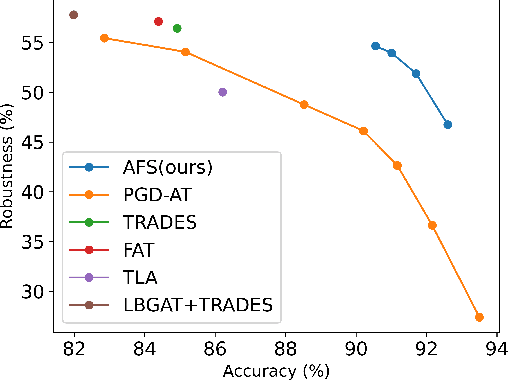
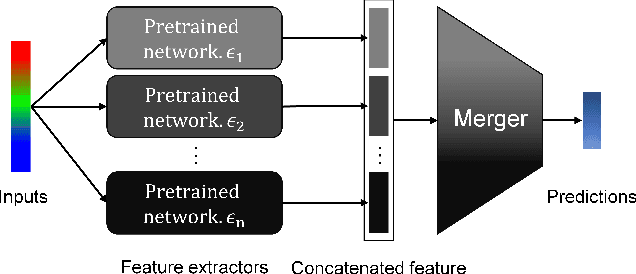

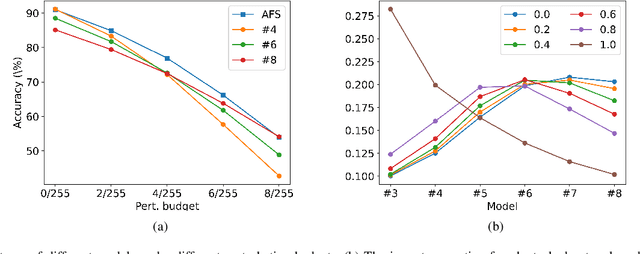
Abstract:Deep Neural Networks (DNNs) have achieved remarkable performance on a variety of applications but are extremely vulnerable to adversarial perturbation. To address this issue, various defense methods have been proposed to enhance model robustness. Unfortunately, the most representative and promising methods, such as adversarial training and its variants, usually degrade model accuracy on benign samples, limiting practical utility. This indicates that it is difficult to extract both robust and accurate features using a single network under certain conditions, such as limited training data, resulting in a trade-off between accuracy and robustness. To tackle this problem, we propose an Adversarial Feature Stacking (AFS) model that can jointly take advantage of features with varied levels of robustness and accuracy, thus significantly alleviating the aforementioned trade-off. Specifically, we adopt multiple networks adversarially trained with different perturbation budgets to extract either more robust features or more accurate features. These features are then fused by a learnable merger to give final predictions. We evaluate the AFS model on CIFAR-10 and CIFAR-100 datasets with strong adaptive attack methods, which significantly advances the state-of-the-art in terms of the trade-off. Without extra training data, the AFS model achieves a benign accuracy improvement of 6% on CIFAR-10 and 9% on CIFAR-100 with comparable or even stronger robustness than the state-of-the-art adversarial training methods. This work demonstrates the feasibility to obtain both accurate and robust models under the circumstances of limited training data.
Brain-inspired global-local hybrid learning towards human-like intelligence
Jun 05, 2020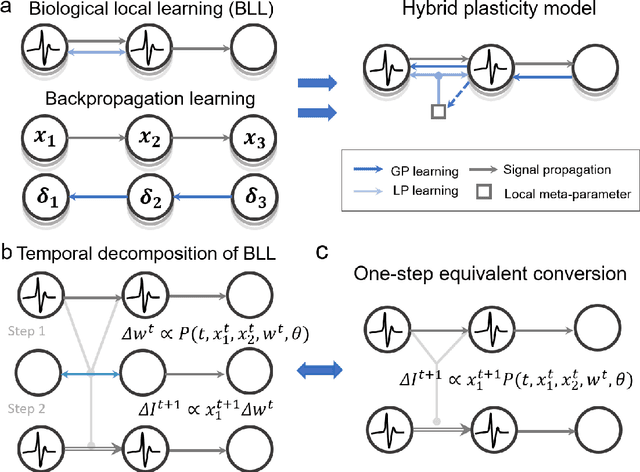
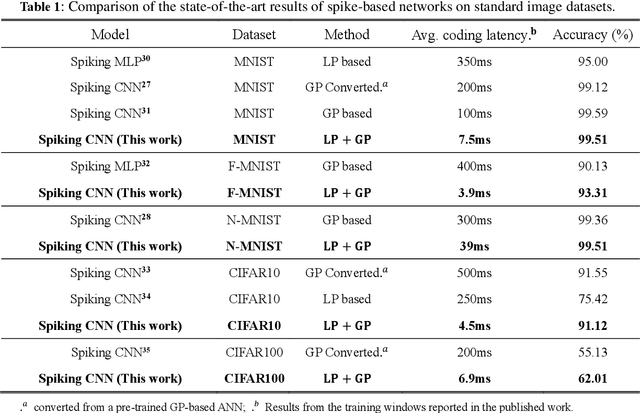
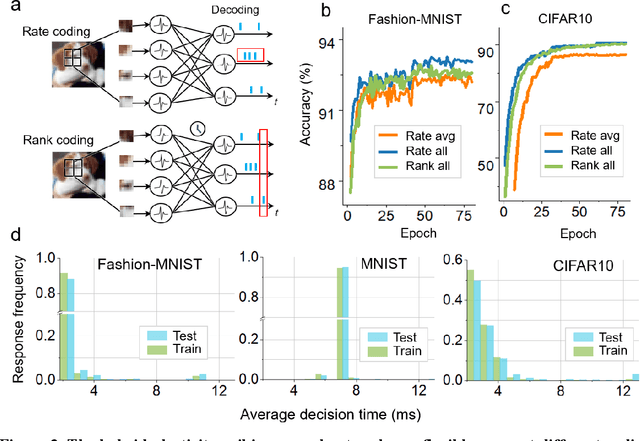
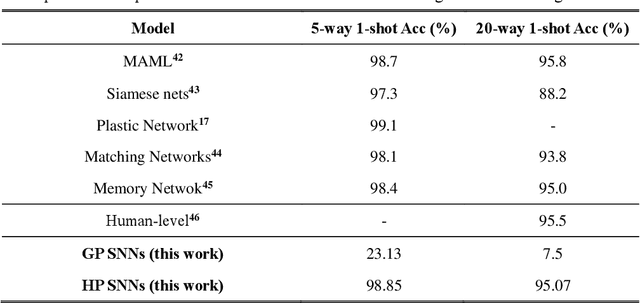
Abstract:The combination of neuroscience-oriented and computer-science-oriented approaches is the most promising method to develop artificial general intelligence (AGI) that can learn general tasks similar to humans. Currently, two main routes of learning exist, including neuroscience-inspired methods, represented by local synaptic plasticity, and machine-learning methods, represented by backpropagation. Both have advantages and complement each other, but neither can solve all learning problems well. Integrating these two methods into one network may provide better learning abilities for general tasks. Here, we report a hybrid spiking neural network model that integrates the two approaches by introducing a meta-local module and a two-phase causality modelling method. The model can not only optimize local plasticity rules, but also receive top-down supervision information. In addition to flexibly supporting multiple spike-based coding schemes, we demonstrate that this model facilitates learning of many general tasks, including fault-tolerance learning, few-shot learning and multiple-task learning, and show its efficiency on the Tianjic neuromorphic platform. This work provides a new route for brain-inspired computing and facilitates AGI development.
Adversarial symmetric GANs: bridging adversarial samples and adversarial networks
Jan 01, 2020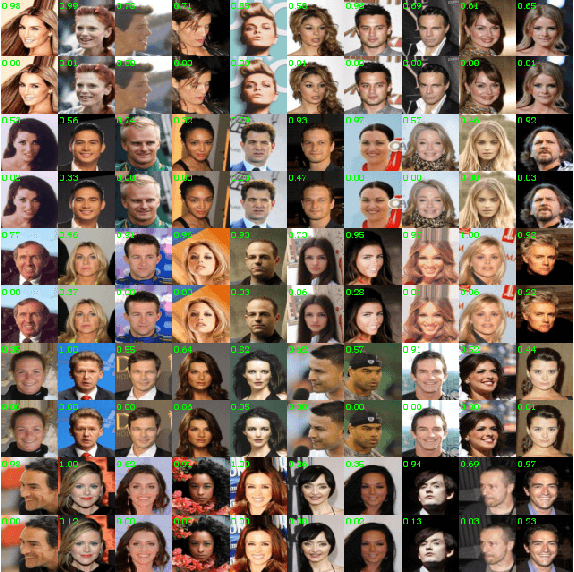
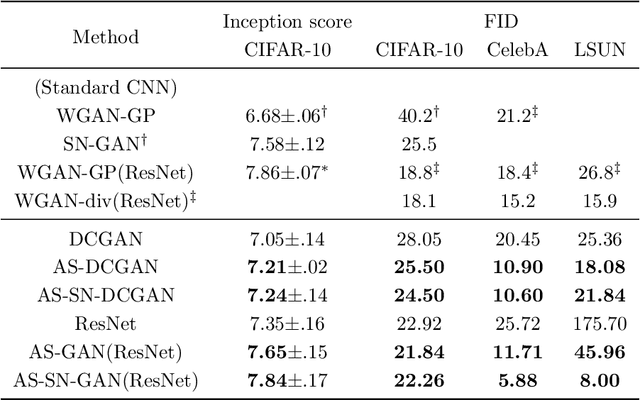


Abstract:Generative adversarial networks have achieved remarkable performance on various tasks but suffer from training instability. Despite many training strategies proposed to improve training stability, this issue remains as a challenge. In this paper, we investigate the training instability from the perspective of adversarial samples and reveal that adversarial training on fake samples is implemented in vanilla GANs, but adversarial training on real samples has long been overlooked. Consequently, the discriminator is extremely vulnerable to adversarial perturbation and the gradient given by the discriminator contains non-informative adversarial noises, which hinders the generator from catching the pattern of real samples. Here, we develop adversarial symmetric GANs (AS-GANs) that incorporate adversarial training of the discriminator on real samples into vanilla GANs, making adversarial training symmetrical. The discriminator is therefore more robust and provides more informative gradient with less adversarial noise, thereby stabilizing training and accelerating convergence. The effectiveness of the AS-GANs is verified on image generation on CIFAR-10 , CelebA, and LSUN with varied network architectures. Not only the training is more stabilized, but the FID scores of generated samples are consistently improved by a large margin compared to the baseline. The bridging of adversarial samples and adversarial networks provides a new approach to further develop adversarial networks.
DashNet: A Hybrid Artificial and Spiking Neural Network for High-speed Object Tracking
Sep 15, 2019

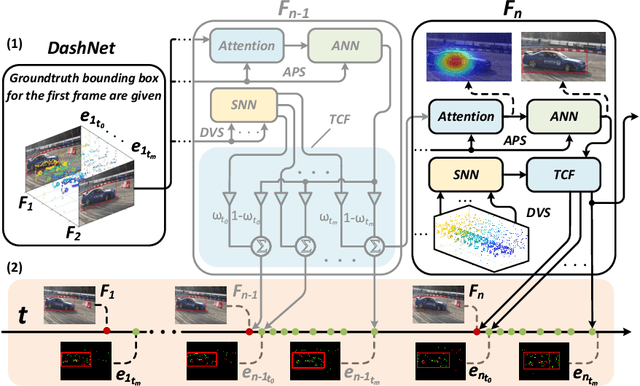

Abstract:Computer-science-oriented artificial neural networks (ANNs) have achieved tremendous success in a variety of scenarios via powerful feature extraction and high-precision data operations. It is well known, however, that ANNs usually suffer from expensive processing resources and costs. In contrast, neuroscience-oriented spiking neural networks (SNNs) are promising for energy-efficient information processing benefit from the event-driven spike activities, whereas, they are yet be evidenced to achieve impressive effectiveness on real complicated tasks. How to combine the advantage of these two model families is an open question of great interest. Two significant challenges need to be addressed: (1) lack of benchmark datasets including both ANN-oriented (frames) and SNN-oriented (spikes) signal resources; (2) the difficulty in jointly processing the synchronous activation from ANNs and event-driven spikes from SNNs. In this work, we proposed a hybrid paradigm, named as DashNet, to demonstrate the advantages of combining ANNs and SNNs in a single model. A simulator and benchmark dataset NFS-DAVIS is built, and a temporal complementary filter (TCF) and attention module are designed to address the two mentioned challenges, respectively. In this way, it is shown that DashNet achieves the record-breaking speed of 2083FPS on neuromorphic chips and the best tracking performance on NFS-DAVIS and PRED18 datasets. To the best of our knowledge, DashNet is the first framework that can integrate and process ANNs and SNNs in a hybrid paradigm, which provides a novel solution to achieve both effectiveness and efficiency for high-speed object tracking.
Convolution with even-sized kernels and symmetric padding
Mar 20, 2019
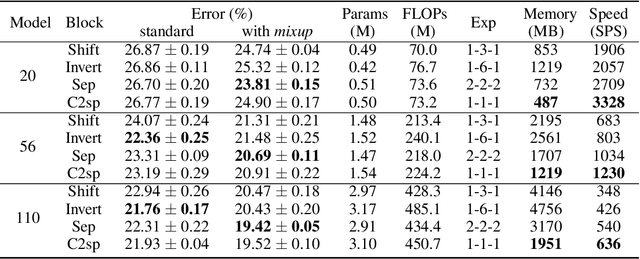
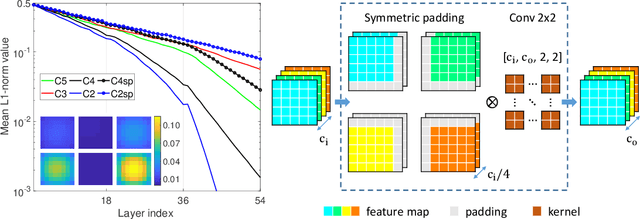
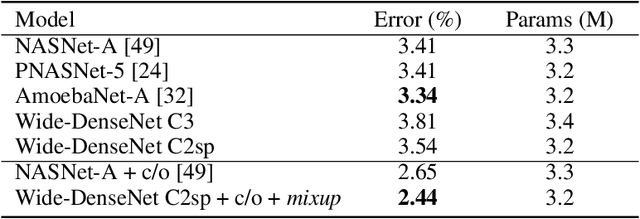
Abstract:Compact convolutional neural networks gain efficiency mainly through depthwise convolutions, expanded channels and complex topologies, which contrarily aggravate the training efforts. In this work, we identify the shift problem occurs in even-sized kernel (2x2, 4x4) convolutions, and eliminate it by proposing symmetric padding on each side of the feature maps (C2sp, C4sp). Symmetric padding enlarges the receptive fields of even-sized kernels with little computational cost. In classification tasks, C2sp outperforms the conventional 3x3 convolution and obtains comparable accuracies to existing compact convolution blocks, but consumes less memory and time during training. In generation tasks, C2sp and C4sp both achieve improved image qualities and stabilized training. Symmetric padding coupled with even-sized convolution is easy to be implemented into deep learning frameworks, providing promising building units for architecture designs that emphasize training efforts on online and continual learning occasions.
Direct Training for Spiking Neural Networks: Faster, Larger, Better
Sep 16, 2018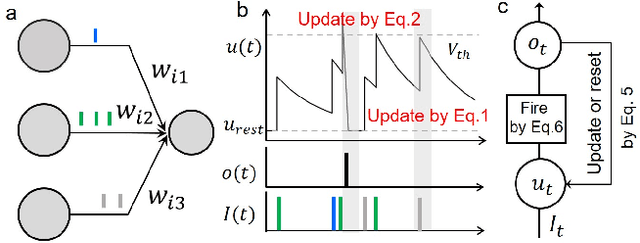
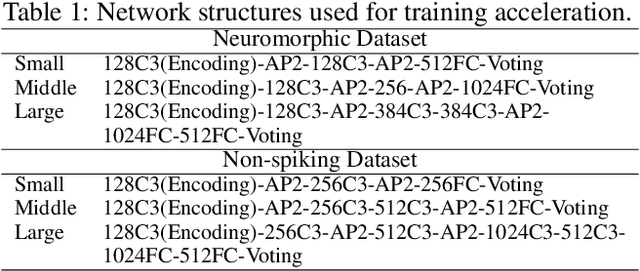
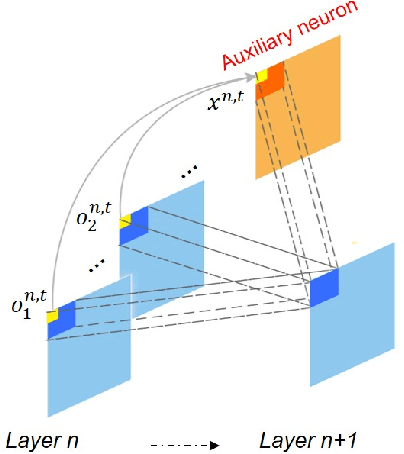
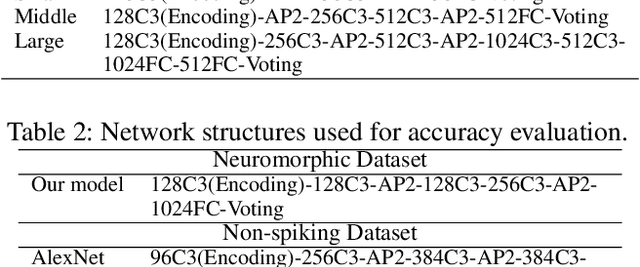
Abstract:Spiking neural networks (SNNs) are gaining more attention as a promising way that enables energy efficient implementation on emerging neuromorphic hardware. Yet now, SNNs have not shown competitive performance compared with artificial neural networks (ANNs), due to the lack of effective learning algorithms and efficient programming frameworks. We address this issue from two aspects: (1) We propose a neuron normalization technique to adjust the neural selectivity and develop a direct learning algorithm for large-scale SNNs. (2) We present a Pytorch-based implementation method towards the training of deep SNNs by narrowing the rate coding window and converting the leaky integrate-and-fire (LIF) model into an explicitly iterative version. With this method, we are able to train large-scale SNNs with tens of times speedup. As a result, we achieve significantly better accuracy than the reported works on neuromorphic datasets (N-MNIST and DVS-CIFAR10), and comparable accuracy as existing ANNs and pre-trained SNNs on non-spiking datasets (CIFAR10). To our best knowledge, this is the first work that demonstrates direct training of large-scale SNNs with high performance, and the efficient implementation is a key step to explore the potential of SNNs.
Robust event-stream pattern tracking based on correlative filter
Mar 17, 2018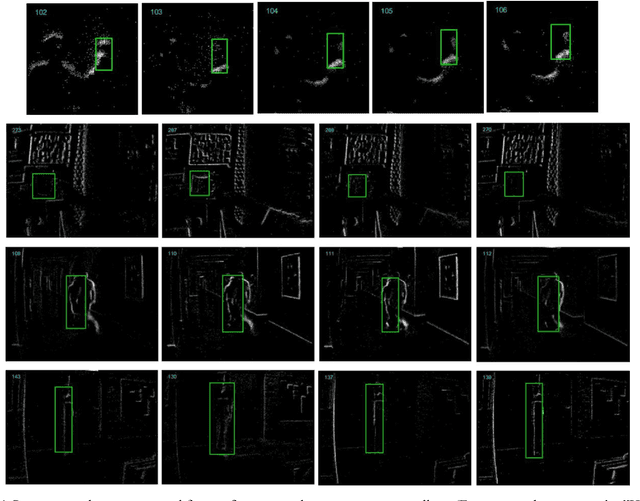
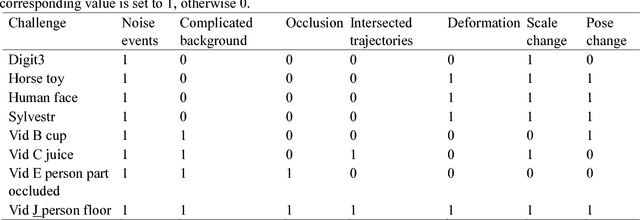
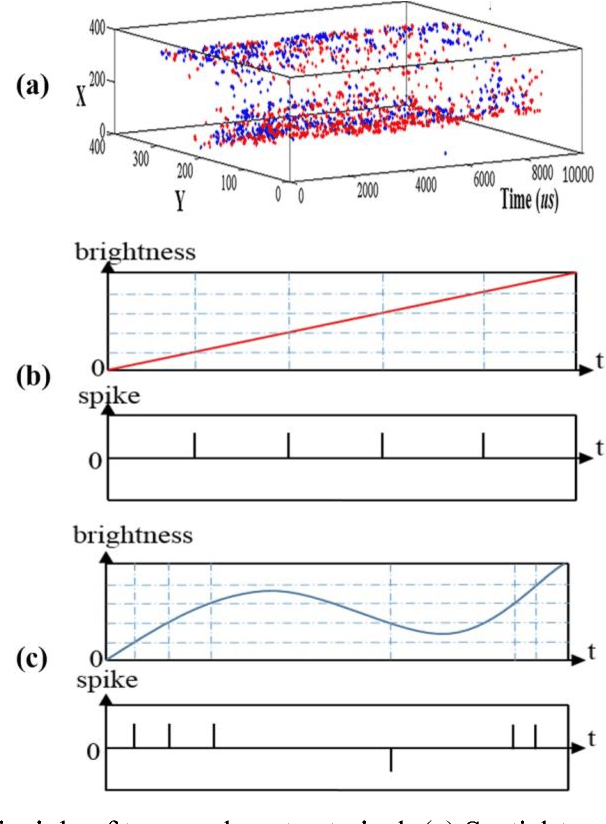

Abstract:Object tracking based on retina-inspired and event-based dynamic vision sensor (DVS) is challenging for the noise events, rapid change of event-stream shape, chaos of complex background textures, and occlusion. To address these challenges, this paper presents a robust event-stream pattern tracking method based on correlative filter mechanism. In the proposed method, rate coding is used to encode the event-stream object in each segment. Feature representations from hierarchical convolutional layers of a deep convolutional neural network (CNN) are used to represent the appearance of the rate encoded event-stream object. The results prove that our method not only achieves good tracking performance in many complicated scenes with noise events, complex background textures, occlusion, and intersected trajectories, but also is robust to variable scale, variable pose, and non-rigid deformations. In addition, this correlative filter based event-stream tracking has the advantage of high speed. The proposed approach will promote the potential applications of these event-based vision sensors in self-driving, robots and many other high-speed scenes.
Super-resolution of spatiotemporal event-stream image captured by the asynchronous temporal contrast vision sensor
Mar 16, 2018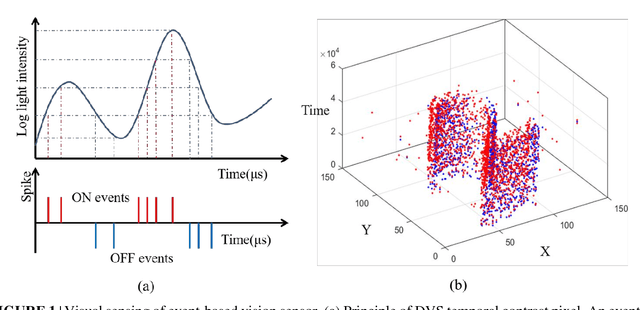
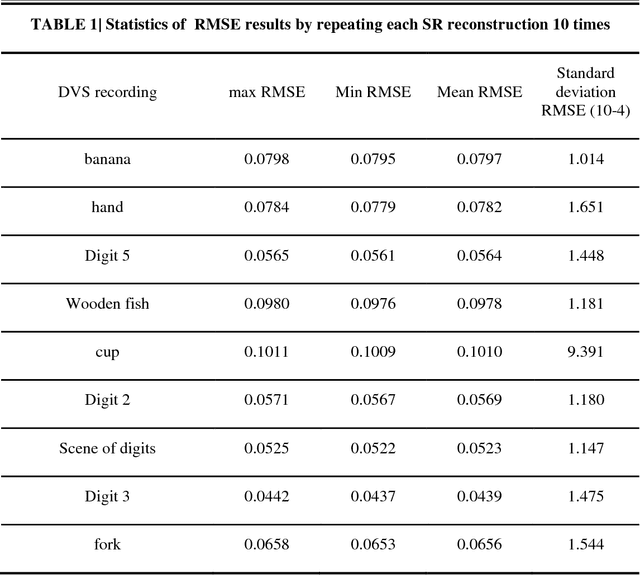
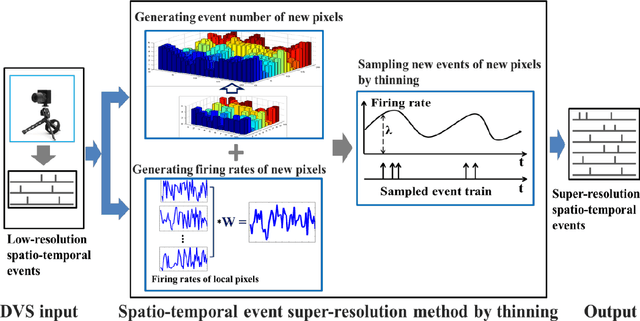
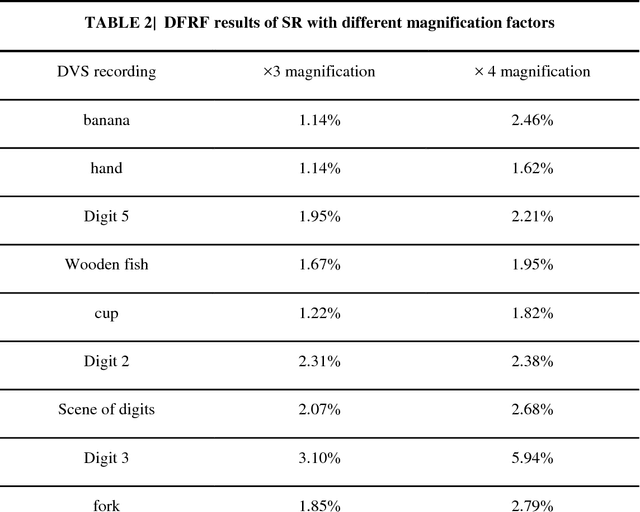
Abstract:Super-resolution (SR) is a useful technology to generate a high-resolution (HR) visual output from the low-resolution (LR) visual inputs overcoming the physical limitations of the cameras. However, SR has not been applied to enhance the resolution of spatiotemporal event-stream images captured by the frame-free dynamic vision sensors (DVSs). SR of event-stream image is fundamentally different from existing frame-based schemes since basically each pixel value of DVS images is an event sequence. In this work, a two-stage scheme is proposed to solve the SR problem of the spatiotemporal event-stream image. We use a nonhomogeneous Poisson point process to model the event sequence, and sample the events of each pixel by simulating a nonhomogeneous Poisson process according to the specified event number and rate function. Firstly, the event number of each pixel of the HR DVS image is determined with a sparse signal representation based method to obtain the HR event-count map from that of the LR DVS recording. The rate function over time line of the point process of each HR pixel is computed using a spatiotemporal filter on the corresponding LR neighbor pixels. Secondly, the event sequence of each new pixel is generated with a thinning based event sampling algorithm. Two metrics are proposed to assess the event-stream SR results. The proposed method is demonstrated through obtaining HR event-stream images from a series of DVS recordings with the proposed method. Results show that the upscaled HR event streams has perceptually higher spatial texture detail than the LR DVS images. Besides, the temporal properties of the upscaled HR event streams match that of the original input very well. This work enables many potential applications of event-based vision.
 Add to Chrome
Add to Chrome Add to Firefox
Add to Firefox Add to Edge
Add to Edge